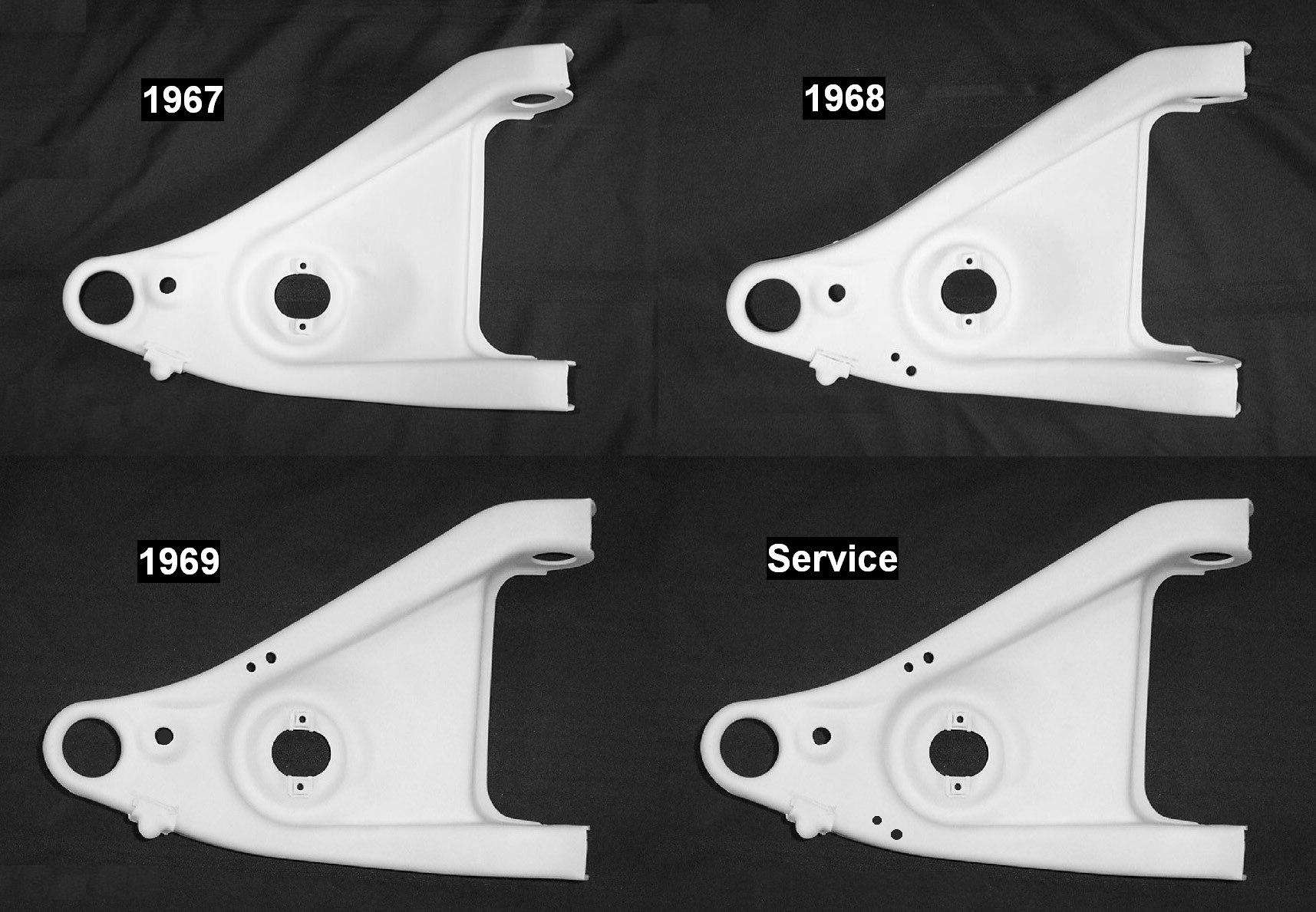Mono-leaf and Multi-leaf Spring Usage

All 6-cylinder cars for all 3 years came with mono leaf
springs.
All 1967 models used mono leaf design rear springs.
For 1968, only models with the 12-bolt rear end received
multi-leaf springs. This included all SS models, the Z28, and the L30/M20
327/275hp 4-speed. All other 1968 models used monoleaf springs.
In 1969, all models with 12-bolt axles
received multi-leaf springs and all models with 350ci engines (10- or 12-bolt) received
multi-leaf springs. Vehicles with 307 and 327 engines received mono-leaf
springs.
The spring rates varied depending on the model, vehicle
weight, and spring options (F41 and G31). The spring part numbers and weight
ranges are shown in the parts manuals and the ride heights are shown in the
Assembly Instruction Manual. Note that not all spring part numbers were sold as
service parts and not all are not reproduced.
Upper A-Arms
The upper a-arms used for all 67-68 Camaros and 69 Camaros with drum brakes and JL8 four-wheel disc brakes were the same design. The 69 J52 disc brake cars used the same basic part, but there were two holes added to the trailing side of the a-arm for mounting a support for the brake hose.
The upper a-arms used for all 67-68 Camaros and 69 Camaros with drum brakes and JL8 four-wheel disc brakes were the same design. The 69 J52 disc brake cars used the same basic part, but there were two holes added to the trailing side of the a-arm for mounting a support for the brake hose.
Lower A-Arms
The lower a-arms used for the 1st-gen Camaros had small but noticeable differences for all three years. This was primarily due to changes in the location of the rubber bump stop which was used to cushion any contact with the frame upon full compression of the suspension. It is unknown why the location of the rubber bump stop changed each year.
The lower a-arms used for the 1st-gen Camaros had small but noticeable differences for all three years. This was primarily due to changes in the location of the rubber bump stop which was used to cushion any contact with the frame upon full compression of the suspension. It is unknown why the location of the rubber bump stop changed each year.
In 67, the rubber bump stop was mounted on a bracket which
was welded to the frame, thus there is no rubber piece mounted on the lower
a-arm and no holes drilled in the a-arm to do so.
For 68, a newly designed larger rubber bump stop was mounted (through two drilled holes) on the trailing side of the a-arm. The mounting bracket for the rubber bump stop (which had been in-line with the centerline of the wheel in 67) was removed and a newly designed metal contact pad for the rubber bump stop was mounted on the trailing side of the coil spring pocket on the frame.
For 69, the same rubber bump stop was moved to the leading edge of the lower a-arm and the corresponding metal contact pad on the frame followed suit to the leading side of the coil spring pocket. All service replacement a-arms included mounting holes for both the 68 and 69 positioning of the rubber bump stop.
Obviously, these holes are not relevant for the 67 application since the rubber piece is on the frame.
For 68, a newly designed larger rubber bump stop was mounted (through two drilled holes) on the trailing side of the a-arm. The mounting bracket for the rubber bump stop (which had been in-line with the centerline of the wheel in 67) was removed and a newly designed metal contact pad for the rubber bump stop was mounted on the trailing side of the coil spring pocket on the frame.
For 69, the same rubber bump stop was moved to the leading edge of the lower a-arm and the corresponding metal contact pad on the frame followed suit to the leading side of the coil spring pocket. All service replacement a-arms included mounting holes for both the 68 and 69 positioning of the rubber bump stop.
Obviously, these holes are not relevant for the 67 application since the rubber piece is on the frame.
The 67 and 68 lower a-arms use welded-in nuts for the lower shock mount. For 69 and for all service replacement a-arms, the shock mounting nuts were attached by a J-clip, which simplified the nut installation and also allowed for easy replacement.
The Assembly Instruction Manuals for all three years show
different part numbers for the lower a-arm assembly for drum brakes and the
lower a-arm assembly for disc brakes. Despite analysis of the parts, the difference
is unknown; it may involve another component of the a-arm assembly.
source: http://www.firstgencamaro.com/suspension.html
No Other Camaro Supplier in the Business Comes Close to Our Selection. We have been serving the Camaro Community since 1976 and Supplying Camaro Parts since 1981.
YOU ARE NOT JUST BUYING PARTS – YOU ARE GETTING OUR CAMARO EXPERTISE
Tags: camaro part, camaro parts, Camaro restoration parts, 69 camaro, 1969 camaro, aftermarket camero parts, chevrolet camaro, ss, z28, rs, chevrolet, restoration, 68 camaro, chevy, 67, 69, f-body, camaro, chevy camaro, chevrolet camaro, gm, z-28, 350, ls1, z/28, pace car, camaro ss, 69 camaro, first generation, copo, fbody, yenko, 67 camaro, 68 camaro, musclecar, second generation
http://www.stevescamaroparts.com

No comments:
Post a Comment